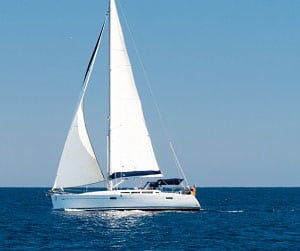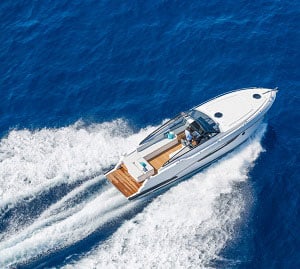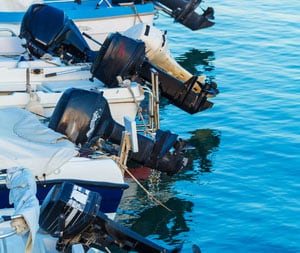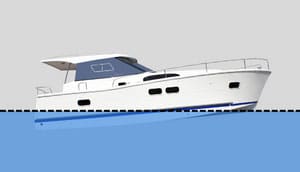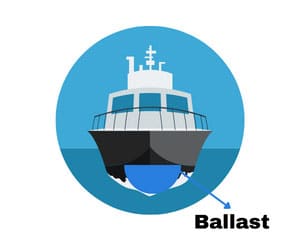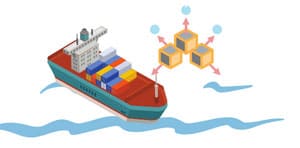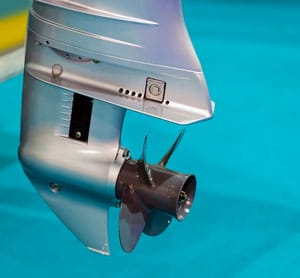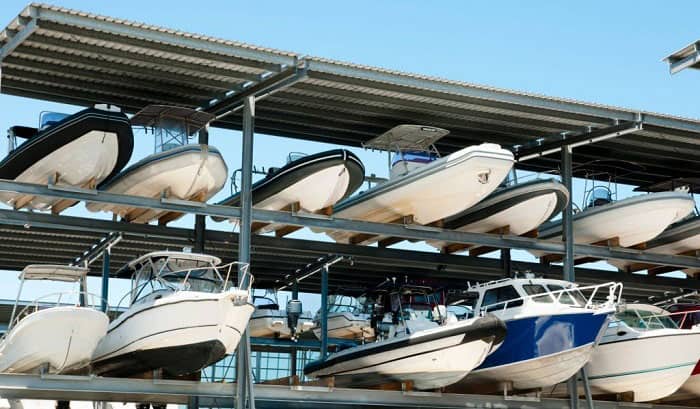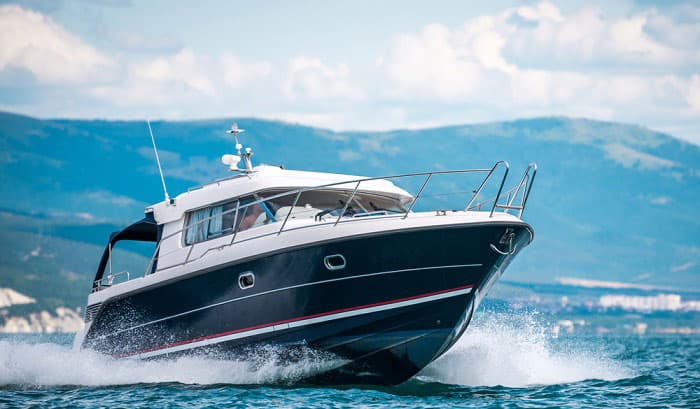The battle for the most stable boat hull designs is a tossup between multihulls (i.e., catamarans, trimarans, and pontoons) and deep Vs. Not far behind are flat-bottomed vessels, though they are only stable in calm waters, thus, limiting their use to inland waterways.
Hence, the most stable boat design hinges on the vessel type and intended use vis-à-vis operating and environmental conditions.
Keep reading to learn more about different boat hulls, especially the most stable ones.
Table of Contents
What Hull Design is the Most Stable?
Manufacturers designing a boat hull always consider the boat’s purpose and the hull’s functional design. Does the hull “ride” on top of the water, or does it displace water?
As the name implies, a displacement hull allows the vessel to push against the water. Hence, these hulls “displace” water and are “slower” than boats with “planing” hulls.
The sailboat hull design is an example of a displacement type. It might be slower than powerboats, but sailboats are very stable.
Does that mean displacement-type hulls are stable? In general, yes, they are very steady, even in treacherous waters. However, some factors can also influence vessel stability.
Good boat designs for maximum stability are condition-specific. As a rule, you can expect a deep-V-hulled boat to be more suitable for rough water adventures than a multi-hulled vessel.
However, different situations call for different solutions. Let us look at different stable hull designs to appreciate our point.
1. Multihulls
The most reliable and stable boat hull design involves at least two hulls in a single vessel.
Examples of multihulls are sailboats (i.e., catamaran and trimaran) and powerboats (i.e., dory and cathedral boats).
However, multi-hulled sailboats are not ideal in extreme waves. Agility can be a concern, too. The good news is that these vessels can take a beating and never capsize.
It is worth pointing out that multihull power boats are less stable than their sailboat counterparts. However, they excel in moderate chops.
2. Monohulls with deep keel
Although keelless displacement hulls can roll easily, they are more reliable, buoyant, and comfortable. The ride quality is super smooth, especially in calm waters. Their exceptional buoyancy allows these boats to carry heavy loads.
Unfortunately, their rolling tendencies can be disastrous in rough waters. Adding an extended keel to the boat hull shape changes these vessels’ instability in extreme weather.
So, if you want to learn how to design a highly stable, ocean-going displacement-type hull boat, you might want to extend the keel as long as possible.
3. Deep-V
Deep V-shaped hull boat designers draw inspiration from a sailboat’s deep keel hull design for exceptional stability in the roughest waters. Although shallower than a sailboat’s keel, the deep-V combines a planing hull’s speed and a displacement boat hull’s ride comfort and stability.
Deep-V boats are a favorite of coastal anglers, allowing them to catch prey near the coast. These boats are also ideal in inland waterways with low to moderately high waves.
It cannot match a multi-hulled vessel’s stability, since a deep-V boat remains a planing hull.
4. Flat-bottomed hull
The most stable small boat you can find has flat-bottomed hulls (i.e., jon boats, dories, gondolas, rafts, and pontoons). A flat and wide bottom is the perfect boat design for holding weight, allowing the vessel to “sit” on the water with exceptional stability.
Unfortunately, you might have the most stable fishing boat, but it can swamp and capsize even in slightly wavy waters. These vessels are only suitable in calm inland waterways.
The following table summarizes the most stable boat hull designs in their ideal environments. Please note that putting any vessel type into a different situation can compromise its stability.
| Hull Design | Conditions for Stability |
| Multiple hulls | Very stable in all weather conditions (except very large waves), regardless of location |
| Single hull with a deep keel | Very stable anywhere, even in areas with large waves |
| Deep-V monohull | Very stable in lakes, rivers, and seas, with low to moderately high waves |
| Flat-bottomed | Very stable in ponds, lakes, rivers, canals, and other inland waterways, with calm zero-wave waters |
Moreover, we summarized a “rule of thumb” to observe when designing or building a stable watercraft. The boat’s speed, area underwater, and width have a direct relation to its stability. In other words, slower boats with wider bodies and a larger submerged bottom area are more steady.
Other Parameters to Determine the Boat’s Performance
Let us look at some parameters influencing a boat’s performance vis-à-vis stability.
1. Engine Mount
Boats with inboard engines do not have issues with stability because the manufacturer already took this issue into thoughtful consideration. However, the case for outboard motors is different.
How you mount the outboard motor can impact the vessel’s stability. Two high or low will lead to increased drag or cavitation. Twin outboards also tend to offer more steadiness than single-engine outboards.
2. Trim Angle
An outboard motor’s trim angle can also influence the vessel’s stability. The trim angle refers to that imaginary line between the propeller shaft and the boat’s bottom.
The ideal trim should be parallel to the waterline, allowing the boat to operate most efficiently. A motor trimmed down can lead to drag, while a trimmed-up engine can produce porpoising and instability.
3. Ballast
Submarines have ballast tanks, allowing them to achieve buoyancy when on the surface and remain submerged. Large cruise liners and container ships also have this element to improve their stability.
4. Weight Distribution
Cargo, equipment, passengers, fuel, and supplies have weight. These factors push the ship into the water, much like gravity pulls us to the ground. Hence, ensuring a uniform weight distribution is necessary for maximum vessel stability.
Ship crews must secure movable items to prevent weight creeps and shifts in severe storms and high waves.
5. Propellers
The correct propeller design is necessary for ensuring optimum thrust through the water, guaranteeing ride comfort and stability.
Other Notable Boat Hull Types
You already know the most stable hull designs across varying conditions. Of course, these are not the only boat hull shapes boaters should know. The following are other noteworthy hull types.
1. Displacement Hulls
As mentioned, displacement-type hulls are a stable design, especially with a deep keel. These vessels can carry a heavy load and move in water slowly.
Unfortunately, these vessels must consume more fuel or energy to “push” against the water. Examples are trawlers, cruise liners, tugboats, and sailboats.
2. Planing Hulls
This hull type is also stable at low speeds, like displacement hulls. Their principal advantage over displacement hulls is their speed. These boats “rise” high on a plane to minimize water resistance, allowing them to blitz. However, they are vulnerable to strong winds.
Powerboats are excellent examples of vessels with planing hulls.
3. Semi-displacement Hulls
Boats with this hull design combine displacement-type stability and a planing hull’s speed and are a good middle ground for those who can’t choose between the two.
You will feel safer with the boat’s stability at low speeds while being able to reach 10 to 20 knots.
4. Round-bottomed Hulls
Canoes are a perfect example of a boat with a round bottom. It is a displacement-type hull, allowing the vessel to give users a smooth and comfortable ride.
The issue with these boats is that they are highly unstable and prone to rolling and capsizing. Stepping into these round-bottom boats can be tricky.
FAQs
What are strakes and chines?
Strakes are elongated flat strips boat designers include in the vessel’s bottom section. Their principal purpose is to minimize swamping from unnecessary water sprays. Deflecting the water offers some degree of stability and lift.
Meanwhile, chines are sharp angular changes in the boat’s hull cross-section.
Reverse chines improve overall vessel stability by maintaining the watercraft’s equilibrium at the keel. You can pilot the boat at break-neck speeds, and it will remain stable. Boaters will also experience a smoother and more comfortable ride, regardless of speed.
What is the most efficient boat hull design?
Planing hulls are the most efficient because they can “cut” through the water with minimal resistance, allowing the boat to consume less fuel than a vessel with a displacement-type hull.
This hull design is the polar opposite of a displacement type. The latter “forces” its way through the water, requiring more energy to move. Unfortunately, it is still slow even with a boost in power, making a displacement-type less efficient than a planing hull.
Conclusion
The most stable boat hull designs are multihulls and deep Vs. Flat-bottomed boats and monohulls with very deep keels are also in the running for exceptional stability. However, multihulls are the steadiest among these four hull types because they are reliably stable in almost any weather.
Broader and flatter hulls are more stable than narrow and angled or rounded designs. Moreover, displacement hulls are steadier in rough waters than planing hulls (meant for speed).
The key takeaway is no single hull design can be the most stable across all water and environmental conditions. Everything depends on its design and use.

Ten years of enjoying countless trips on boats never made me love them any less! So I am here to put all those experiences into good use for other boaters who want to have a safe and fun trip with their friends and families.



